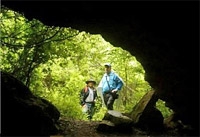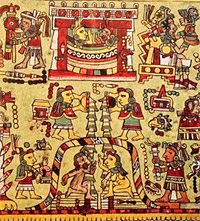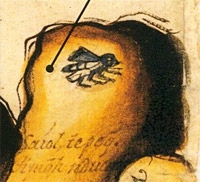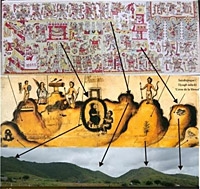2011 Monte Alban
At the VIth Monte Albán Round Table conference (July 2011) in Oaxaca, Mexico, Maarten Jansen (Leiden University) together with Mexican archaeologists Dante García and Iván Rivera (both from the Instituto Nacional de Antropología e Historia) discussed the topography and toponyms of the archaeological zone of Monte Albán. They presented new evidence for Jansen's earlier identification of this site in the Mixtec pictorial manuscripts.

Monte Albán is a famous Zapotec capital of the Late Preclassic and Classic period (approx. 500 B.C. - A.D. 850). The Mixtec pictorial manuscripts deal mainly with the dynastic history of the Mixtec city-states during the Postclassic period (approx. 950 - 1521). The references to Monte Albán in this context is important for understanding how Postclassic society constructed memories about earlier times and for interpreting historical, social and ideological aspects of how the Classic period came to en end (the so-called "Classic Collapse").


In this process they also located the steep cliff with still another cave which is painted as the other end of the big mountain in Codex Nuttall, p. 19. This must be the large rocky area at the southern end of Monte Albán, known as 'El Paredón', which indeed contains a small cave. In this manner they could decipher the set of toponymic signs in the codex as a cluster of geographical elements and place signs that form part of Monte Albán. Particularly convincing is the fact that the spatial relationships between the pictorial signs coincide completely with geographic reality. A detailed presentation will be published in the volume with the papers of the VIth Monte Albán Round Table conference.

During the same Monte Albán Round Table conference a new permanent exhibition was opened at the site museum of Monte Albán, featuring a human skull and a conch (stombus gigas), both decorated with reliefs in the Postclassic 'Mixteca Puebla style'. These extraordinary objects were recovered from illegal artefact traffic in the U.S. Mexican archaeologist Pedro Francisco Sánchez Nava coordinated a multidisciplinary team to investigate their authenticity and significance. The book that presents the findings of this team ('Un Cráneo y un Caracol de estilo Mixteca-Puebla: Patrimonio Recuperado') was officially presented during the conference. It includes a chapter by Maarten Jansen (Leiden University) on the interpretation of the relief carvings. Analysing the images and comparing them to scenes in the religious and historical pictorial manuscripts from ancient Mexico, Jansen concludes that in both cases the pictorial texts refer to ritual acts of ancestor veneration and visionary contact with the Other World.
